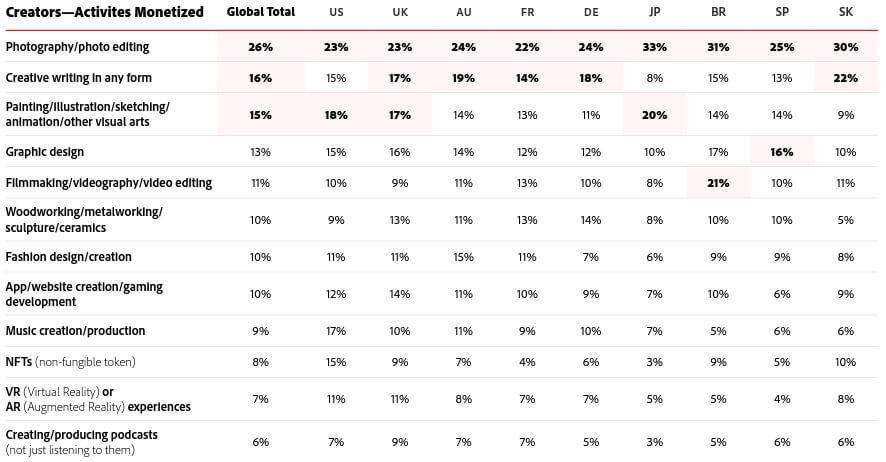
Study: Metaverse and NFTs among areas creators monetise
share on
The majority of non-professional creators (68%) expect the metaverse to bring new job opportunities as it continues to grow. At the same time, 77% of creators have explored the metaverse at least once, and 34% say they are already participating weekly, through early metaverse experiences including gaming, socialising and shopping, according to an Adobe study titled "Monetisation in the Creator Economy".
Meanwhile, 52% of creators who participate in the metaverse weekly say they are already working towards owning their own creative businesses. Equal number of creators who participate weekly in metaverse activities see it as a place for games (55%0 and a venus for socialisation (55%), while 29% see the metaverse as a place to attend virtual concerts, trade shows, and learning events.
Creators are also see the metaverse as a place for business: a place to purchase NFTs (29%), create NFTs (24%), and buy virtual real estate (19%). The report is part of its Future of Creativity study which Adobe conducted in May this from among 9,000 non-professional creators across Australia, Japan, South Korea, Brazil, the US, UK, Spain, France, and Germany.
Growth in creator economy due to monetisation opportunities
Nearly half of non-professional creators (48%) now earn money from their creative activities, with higher percentages in Brazil (59%), the US (53%), Germany (51%), the UK (51%), and South Korea (51%). While 77% only began monetising their content in the past year, 48% of monetisers say revenues from creative endeavours represent more than half of their monthly income. In fact, NFTs (8%), VR/AR experiences (7%), and creating/producing podcasts (6%) are among the list of activities that creators monetise.

NFTs and VR/AR experiences were also among the segments chosen by 78% and 67% of monetisers respectively that showed the greatest potential for growth. Interestingly, the metaverse was cited by 22% of Gen Z monetisers, in particular, as anticipated areas of growth.
Adobe classifies monetisers as those who earn income through their creative activities by selling via websites or marketplaces or via promotional revenue from partnerships, affiliate links, and ad revenue. Creators, on the other hand, are defined as non-professionals over the age of 18 who either participate in creative activities and post, share or promote their work online, or are dedicated to creating social content on a monthly basis.
According to Adobe, sources of financial income are split evenly between promotional revenue (65%) and selling D2C via online/offline channels (67%). More specifically, Brazilian and South Korean monetisers are more likely to be bringing in promotional revenue, while monetisers in the US and Germany are earning via direct sales through online and offline channels.
Four in 10 monetisers are making more money now than they were two years ago, and of those, eight in 10 anticipate earning even more in the next two years. In fact, monetisers across all creative activities are earning at least six times the US minimum wage (US$7.25/hour). The US, Brazil, Spain, and the UK are expected to see the highest levels of earning potential growth in the next two years.
Digital Marketing Asia is back for its 10th year! 10 years of exclusive insights, experience sharing and great success stories. Join us for three days of hyper-focused presentation topics across six tracks on 15 - 17 November. Click here to register now!
Content creation or college - what do Gen Z want?
Close to half of (49%) Gen Z monetisers between 16 to 18 years old prefer to launch their own creative businesses rather than attend college. Also, Gen Z monetisers are earning higher hourly rates despite spending similar amounts of time on creative activities. In fact, they are averaging US$58 per hour for 11 hours of work per week, whereas monetisers average US$52 per hour in earnings for the same amount of work.
Gen Z monetisers are also betting on growth industries including gaming (40%), photography (36%), and social media (34%). At the same time, 54% of Gen Z monetisers anticipate earning more in the next two years than they did in the past two years.
What roles do ethnicity and gender play in the creator economy?
Despite pay equity gaps, black, indigenous and people of colour (BIPOC) creators are among the creator economy's most ambitious groups. Adobe found that the pay equity gap persists for women and BIPOC creators who respectively earn 22% and 23% less per hour than their counterparts.
On average, monetiser men earn US$55 per hour compared to US$44 per hour for monetiser women, and BIPOC monetisers earn an average of US$49 per hour, compared to an average of US$62 per hour earned by white monetisers.
Slightly over a third of BIPOC creators (32%) started creating with the hopes of turning it into a career, compared with only 25% of white creators. Over half (53%) are actively working towards owning their own businesses compared to 42% of white creators. Meanwhile, 80% of BIPOC creators currently monetise some form of creative activity, while 38% are specifically monetising original social content, compared with 68% and 33% for white creators, respectively.
Digital Marketing Asia is back for its 10th year! 10 years of exclusive insights, experience sharing and great success stories. Join us for three days of hyper-focused presentation topics across six tracks on 15 - 17 November. Click here to register now!
share on
Free newsletter
Get the daily lowdown on Asia's top marketing stories.
We break down the big and messy topics of the day so you're updated on the most important developments in Asia's marketing development – for free.
subscribe now open in new window
